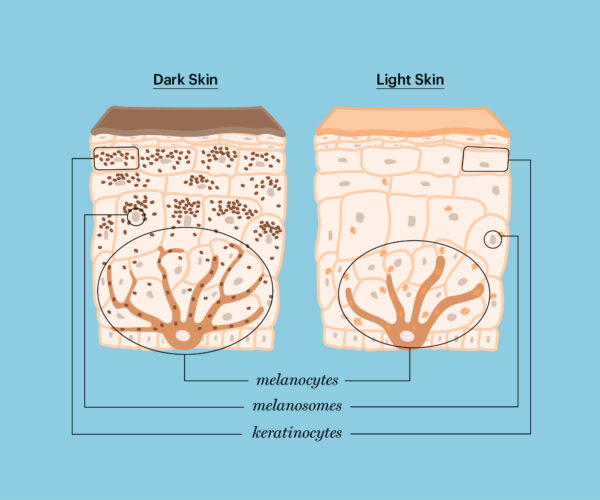Credit: PeopleImages/iStock/Getty Images
The answer is yes, but it’s more complex than that, as we are learning that personal risk is based on many individual factors that include everything from your skin tone to your hereditary background. We dig into the facts about skin of color and skin cancer, so you can protect your skin.
Maybe you’ve heard it before: “Black people don’t need sunscreen!” Or “People of color aren’t at risk for skin cancer.” But the truth is, if you have skin, you can get skin cancer, regardless of its color. In fact, skin cancer accounts for 1 to 2 percent of all cancers in Black people, 2 to 4 percent in Asian people and 4 to 5 percent in Hispanic people. Yes, those numbers are far lower than they are for white people, but when skin cancer does occur in skin of color, it tends to be diagnosed at a later stage and has a worst prognosis. The estimated five-year melanoma survival rate for Black patients is only 70 percent versus 94 percent for white patients. Plus, unprotected sun exposure can lead to other issues such as unsightly sun damage.
We dug into the facts about skin cancer and people of color, dispelling the top myths and setting the record straight.

First, a Primer on Skin Tone
Where does skin get its color? If you said, “from melanin,” you’d be correct, but it’s not that simple. All skin tones produce melanin, and it’s a complex system that varies from person to person. The process starts inside a melanocyte, a pigment-producing cell (these are also the cells from which melanoma arises); only it’s not the number of melanocytes you have that determines your specific skin tone. Instead, it’s partly the type of melanin these cells produce. It’s also the size and distribution of melanosomes, which are like little packages of melanin made by the melanocytes that then carry the melanin to other skin cells.
Melanocytes produce eumelanin, which gives skin and hair brown and black pigment, and pheomelanin, a type that appears red and yellow. The ratio of eumelanin to pheomelanin determines your skin color, and that can vary greatly. Those with darker skin are genetically predisposed to produce more eumelanin, the type that provides at least some protection against ultraviolet (UV) damage. Those with light skin typically have more pheomelanin, which doesn’t offer UV protection. Several factors influence how much melanin your cells produce, including UV exposure, hormones, genes and inflammation.
Once the melanin is made, it’s stored inside the melanosomes. The melanosomes then travel up through the melanocyte cell and transfer to keratinocytes, another type of skin cell, via dendrites (think one-way passages between cells). The newly pigmented keratinocytes then make their way to up to the skin’s surface, creating your unique skin tone. Darker skin tones have larger melanosomes spread out inside the cell (which translates to evenly distributed melanin on the skin’s surface). People with lighter skin tones tend to have smaller melanosomes clustered together. That’s why some people get spotty bits of melanin, aka freckles, after sun exposure.
Common Myths About Skin Cancer and People of Color
One of the main culprits of skin cancer is exposure to UV radiation from the sun or indoor tanning. UV rays can damage the DNA in skin cells in the epidermis (the outermost layer of skin), triggering mutations that cause skin cells to multiply and form malignant tumors. Many assume that skin of color has protection against this type of damage. While that’s partially true (as you’ve just learned above), it’s not enough to fully protect your cells and the protection level varies depending on your skin tone. Read on for more on this misconception — and others surrounding skin of color and skin cancer.
Myth: Skin cancer in dark skin isn’t caused by the sun.
Fact: Melanoma in dark skin is more likely to appear where the sun doesn’t shine, such as the palms of the hands and soles of the feet, especially with acral lentiginous melanoma (ALM), a rare and aggressive type of skin cancer that often appears on those areas. However, squamous cell carcinoma, the most common type of skin cancer in Black patients, is highly linked to UV exposure. Plus, skin tone is not the only risk factor: genetics, gender, age, certain medications and medical conditions play a role in determining your individual risk for developing skin cancer, too. “Every person of every race needs a full skin check from head to toe every year to see if they have any suspicious lesions,” says Jeanine B. Downie, MD, a dermatologist in private practice in Montclair, New Jersey. They should also check their skin regularly for anything new, changing or unusual and alert their dermatologist as soon as possible.
Myth: Darker skin tones provide natural sun protection.
Fact: “There’s a false belief that melanin is more protective than it really is,” says Dr. Downie. As mentioned, eumelanin, the type of melanin that’s predominant in skin of color, does absorb some of the ultraviolet (UV) rays that hit the skin, which may allow more leeway in the sun. But the darkest skin tone only provides the equivalent of SPF 13 — not high enough for sunscreen to earn The Skin Cancer Foundation Seal of Recommendation for safe and effective sun protection.
Myth: People of color don’t need to worry about getting sunburned.
Fact: While skin of color may not show the visible redness of a burn, it does, in fact, burn in the sun. Your skin may darken, feel warm to the touch, crack or eventually blister. Plus, the inflammatory response from the burn can trigger hyperpigmentation (dark spots).
Myth: Sun protection isn’t necessary for skin of color.
Fact: Sun damage that may look like freckles or a tan in light-colored skin may look like dark spots and uneven skin tone in skin of color. We now know that the visible light portion of the solar spectrum can intensify hyperpigmentation and other skin problems such as melasma in skin of color. “It’s a condition that’s very unsightly and can be psychologically disturbing,” says Henry W. Lim, MD, a dermatologist at the Henry Ford Medical Center in Detroit, Michigan, and a long-time member of The Skin Cancer Foundation’s Photobiology Committee. “It often takes months to resolve, even while using bleaching creams. It’s not a disease, but for the sake or patients’ well-being, we need to minimize it.”
Using a broader-spectrum sunscreen tinted with iron oxide can reduce these risks and help the product blend into the skin. These products are now widely available. Covering up with sun-protective clothing, hats and sunglasses can help skin of any color look its best.
The Bottom Line?
People of color may be less susceptible to skin cancer, but there’s still a risk. Plus, all skin tones are vulnerable to sun damage. Your best bet, regardless of your skin color, is to apply sunscreen to exposed skin and practice sun-smart behavior: wearing protective clothing and accessories and seeking shade whenever possible.





